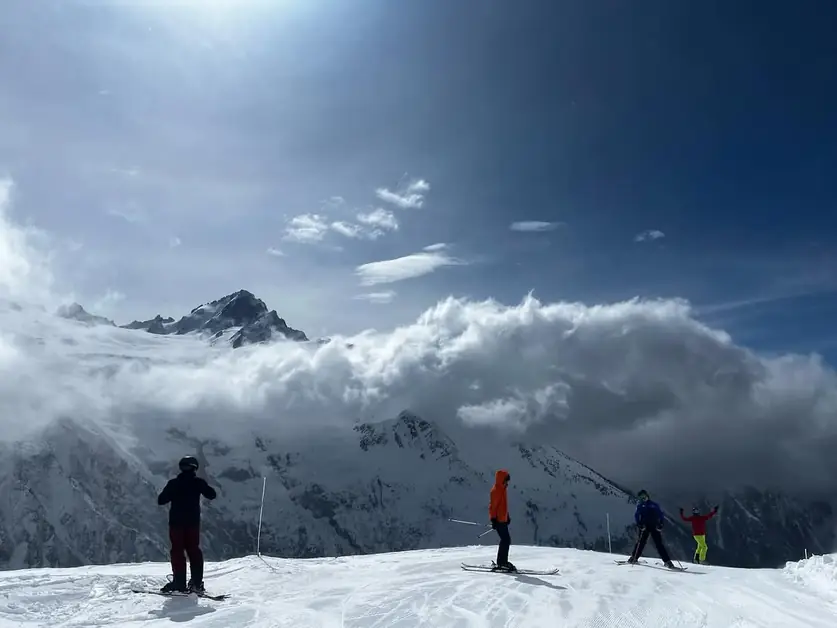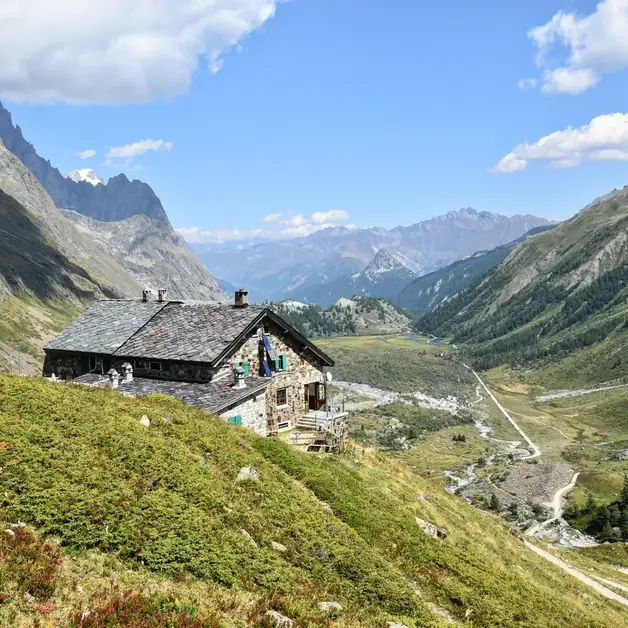Aiguille des Glaciers unique ski mountaineering adventure
The Aiguille des Glaciers offers a unique ski mountaineering experience.

What is the Aiguille des Glaciers?
The Aiguille des Glaciers is a majestic peak of the Mont Blanc massif, located between Italy and France, at the border of Val Veny (Courmayeur) and French Savoie. With its 3,816 meters of altitude, it dominates a spectacular glacial landscape and represents one of the most sought-after destinations for high-altitude ski mountaineering enthusiasts. This mountain fascinates with its grandeur and its wild and remote environment, far from the major tourist routes of Mont Blanc, yet easily accessible for those familiar with the Val Veny area and the Elisabetta Refuge.
Where does the ski mountaineering itinerary for the Aiguille des Glaciers start?
The ascent generally starts near the Elisabetta Soldini Montanaro Refuge (2,195 m), located at the end of Val Veny, a perfect base camp. From the refuge, one climbs towards the Estellette glacier, with a spectacular view of the Pyramide Calcaires and the glacial moraine dominating the entire basin. The environment is grand and solitary, with scenery alternating between snow, ice, and limestone rocks, making the ascent a captivating experience for every ski mountaineer.
What is the first section of the itinerary like?
From the refuge, one follows the slope towards the col at an altitude of 2,550 m, located to the right of the Pyramides Calcaires. This first section is gentle and panoramic but requires caution in case of hard or icy snow. Upon reaching the col, one continues eastward to tackle a steeper section at an altitude of 2,720 m, along the ridge coming from the Col de la Seigne, the pass that separates Italy and France and marks the entrance to the heart of the Mont Blanc massif.
How does the ascent on the glacier develop?
From an altitude of 2,700 m, one aims for the saddle at an altitude of 3,001 m, known as the Cabottes ridge. Here, the environment becomes more glacial, and the ascent enters the most spectacular part of the route. One accesses the Ghiacciaio des Glaciers, a wide but steep and crevassed glacier in the first part. It is important to maintain a good track, especially in the early morning hours when the snow is more stable. The use of complete glacier equipment (harness, rope, ice axe, and crampons) is highly recommended.
How do you reach the Dome des Glaciers?
After surpassing the steepest part of the glacier, the itinerary continues on gentler slopes, allowing ascent towards the Dome des Glaciers (3,590 m), a vast snowy plateau that offers an exceptional view of the entire massif. From here, on clear days, one can admire the entire Mont Blanc chain, the Aiguille de Tré la Tête, the Tête Nord des Fours, and the peaks of Gran Paradiso in the distance.
Is it possible to reach the summit of the Aiguille des Glaciers?
Yes, but the complete ascent to the 3,816 m of the main summit is not recommended for everyone. From the Dome des Glaciers area, one can ascend up to an altitude of 3,700 m, where a stunning panorama opens up over the southern face of Mont Blanc. However, the northern ridge leading to the summit is described as unstable and rotten, with friable and dangerous rocky sections, so many ski mountaineers prefer to stop at the Dome or at the viewpoint at 3,700 m.
Are there any variants or alternative routes?
Yes. Those seeking a more technical ascent can choose to climb the channels below the summit, routes that are particularly interesting at the beginning of the season when the snow is still abundant and compact. These itineraries, however, require excellent mountaineering experience and knowledge of the mixed ice-rock terrain. For detailed information, it is advisable to consult the book by François Damilano, Glace et Mixte du Massif du Mont-Blanc, Vol. II, considered a reference guide for high mountain itineraries in the area.
What is the difficulty level of the ascent?
The overall technical difficulty is classified as AD- (Fairly Difficult -). This means that, while it is not an extreme ascent, it requires good physical condition, experience on glaciers, and the ability to move safely on slopes of 35-40° with exposed sections. In spring, the snow can be more compact and safe, while at the end of the season, crevasses and seracs often emerge, necessitating greater caution.
What is the best season for ski mountaineering on the Aiguille des Glaciers?
The ideal period is from March to May, when the glacier conditions are more stable and the snow cover allows skiing down to the valley floor. At the beginning of the season, one can start with skis already from the Elisabetta Refuge, while in the later season, it may be necessary to carry skis for a stretch. In summer, however, the ascent is more suitable as a hiking itinerary on foot, as the temperatures make the glacier more crevassed and unstable.
What kind of panorama does the Aiguille des Glaciers offer?
The panorama is one of the most spectacular in the entire Mont Blanc massif. From the Italian side, one dominates the entire Val Veny, with a view of the Glacier de la Lex Blanche, while to the north opens the majestic Dôme du Goûter chain. On clear days, one can also see the Aiguilles de Tré la Tête, the Tête Nord des Fours, and, in the distance, the Gran Paradiso and the Aosta Valley. It is a pure and grand high mountain environment, where the silence is broken only by the sound of skis on the snow and the wind blowing between the ridges.
What precautions should be taken?
Start early to avoid the risk of avalanches and soft snow. Use complete glacier equipment. Consult the regional snow bulletin. Avoid the northern ridge if you do not have advanced mountaineering experience. Plan the return with a margin of time and light.
Why choose the Aiguille des Glaciers for ski mountaineering?
Because it offers a perfect balance between adventure, natural beauty, and mountaineering technique. Far from the most beaten paths, it gives the authentic feeling of exploration and true mountain. It is an ascent that combines physical effort, breathtaking landscapes, and absolute silence, elements that make ski mountaineering on Mont Blanc an unforgettable experience.
